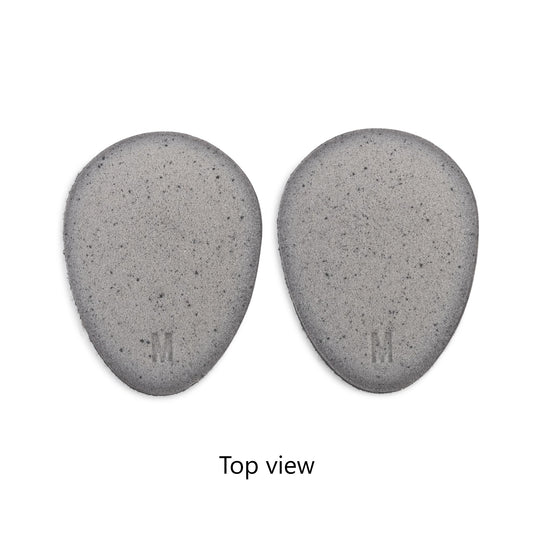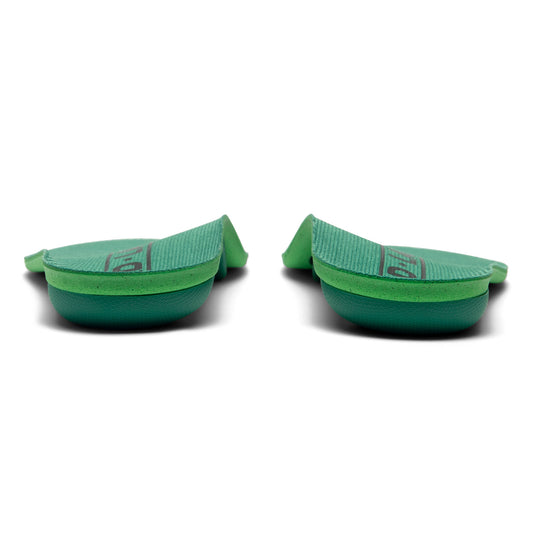
While the causes of forefoot pain are varied, the recommendation on getting relief usually leads to one type of solution - metatarsal foot pads. Designed to alleviate your pain and get you on your feet again, metatarsal pads, or met pads for short, can get you back to being pain free, so you can enjoy all your regular activities again. Read on to find out how metatarsal pads can help you.
The Basics
Recommended by podiatrists and other health care professionals, metatarsal pads (met pads for short), provide pain relieving support to your metatarsal bones.
Forefoot pain that can be addressed with met pads is primarily caused by, metatarsalgia, bursitis of the feet, rheumatoid arthritis, neuromas and plantar warts.
The best metatarsal pads are ones that attach to your insole, rather than your foot, and are easily adjustable. You may need to adjust the met pad a few times to figure out the right spot for it, so velcro is better than adhesive.
What You Need to Know
A metatarsal pad, or met pad for short, is a common solution to forefoot pain. Recommended by podiatrists and other health care providers, the pads provide pain relieving support to the metatarsal bones.
Table of Contents
What are the Medical Causes of Forefoot Pain?
If you're bothered by pain in the balls of your feet, chances are you're suffering from one of a variety of ailments related to your metatarsal bones.
Each of your feet has five metatarsal bones, and the forward ends of these bones form the “ball” of your foot. Proper support of these bones can relieve and prevent forefoot pain.
Forefoot pain can be caused by:
- Metatarsalgia – This term describes the general symptoms of forefoot pain. It is often used as a catch-all for forefoot ailments.
- Bursitis of the feet – Bursitis is an inflammation of the fluid filled sacs that cushion joints in the body. In the feet, it can manifest as achy, swollen joints with restricted motion. Bursitis is often most painful in the morning.
- Rheumatoid arthritis (RA) – The forefoot is the most common place for RA to produce discomfort. RA is an inflammatory condition that affects joints in the body.
- Neuromas – This thickening of the nerve that runs through the ball of your foot can produce a burning sensation, often between the 3rd and 4th toes. It is sometimes caused by shoes that are too tight at the ball of the foot.
- Plantar Warts – Caused by a virus, these warts are located on the soles of the foot. They are usually harmless and go away by themselves within a couple of years. They can however, be uncomfortable when they are in a weight bearing location.
How Met Pads Relieve Forefoot Pain
Metatarsal support pads work by reducing the pressure on the ball of your foot by supporting the metatarsal bone just behind the ball of your foot. By distributing some of the pressure to the shafts of the bones, the pads diminish the pressure on the balls of your feet.
Michael Mueller, PT, PhD, division director of research in physical therapy at the Washington University Medical School of Medicine says, "It's all about the stress transfer, so what you’re trying to do is unload a certain spot on the foot—generally the met head with a met pad—and transfer it to a more proximal region."
Be aware, however, that metatarsal support pads are not cushions located under the balls of your feet. Instead, they are strategically placed pads, just behind the balls of your feet. For some, getting the right placement can be trial and error.
"Modifications and adjustments are part of the game when dealing with met pads, and sometimes you need to rip them off and try something different for the best fit," says Ryan Robinson, CPed and former president of the Pedorthic Association of Canada.
When positioned properly, metatarsal foot pads help to take some of the load off the balls of your feet. But make sure you're getting the right solution.
Many products sold as met pads are actually forefoot cushions. And while "metatarsal cushions" may provide some pain relief, they will not address the underlying issue and will not give you long-term metatarsalgia relief.

What Metatarsal Pad Material Is Best?
Metatarsal pads come in a wide variety of materials, but all are designed to do one thing: reduce your foot pain. Metatarsal pads are most commonly made from the following materials:
- Open-cell polyurethane foam – Delivers long term resilient cushioning.
- Wool or polyester felt – Less resilient and firmer than polyurethane foam, felt is best if very firm support is needed. However, felt can be slow to dry which can be a negative.
- Latex and leather – Leather is used to reinforce the softer latex material. Some people are allergic to latex materials and should avoid using this type of met pad.
There are also forefoot cushioning pads made from stretchy gel materials that dissipate shock very well. As noted above, these are forefoot cushions, not metatarsal support pads, and do not unload pressure on the balls of the foot.
Keep in mind, if you're buying metatarsal pads that will come into contact with your foot, you'll want to find ones with an effective antimicrobial treatment that will prevent odor causing bacterial growth.
What Is The Best Shape For Metatarsal Pads?
Metatarsal pads are available in a variety of shapes, including:
- Met dome
- U-shaped pad
- Donut shaped pad
When testing the various shapes on runners, researchers found the dome shape was the most effective met pad option for reducing pressure. The U-shaped pad was the second most effective, while the donut shaped pad didn't result in significant changes. Study participants found the met dome shape to be the most comfortable.
Karl Landorf, PhD, a senior lecturer and research coordinator in the Podiatry Department at La Trobe University says, "Patients with relatively uncomplicated forefoot pain will generally benefit the most from a met dome. In particular, anyone with pain under the middle metatarsal heads, and that includes both younger and older adults.”
How Do Metatarsal Foot Pads Stay in Place?
Once you've established that a metatarsal pad might be the solution to your foot pain, it's time to think about how you want to wear them.
Self-stick to the bottom of your foot
Sometimes the met pad features self-stick adhesive to adhere directly to the bottom of your foot. There are several problems with this design:
- Adhesives can be irritating to the skin.
- Getting the right location may take some trial and error. The stickiness of the pad may be compromised as you re-position to get the right fit.
- Pads that are in such close contact with the foot are more likely to wear out or develop odors.
- Sticking pads to the bottom of your feet each day is inconvenient.
Self-stick to the top of the insole in your shoe
If you have an insole or shoe that you're happy with, a met pad can be strategically placed to provide the best relief. Advantages if this design include:
- After trial and error to determine the best location, your met pads will be there for you every day.
- Separated from your foot by a sock, your met pads will last longer and stay cleaner.
- Less chance of a skin irritation from adhesive.
Velcro attachment underneath your insole
This unique design uses Velcro to attach the met pad under the top surface of your insoles. It is designed to work with Tread Labs insoles for metatarsalgia. This system has the advantages listed above plus:
- Velcro does not lose its grip like adhesives, allowing for many adjustments without compromising the attachment.
- As you put your shoes on each day, you will not peel the met pad from the insole. It is protected, below the top of the insole.
- Putting the pad under the top cover of the insole protects it from the foot. The anti-microbial nature of the top cover keeps the met pads from becoming havens for dirt and bacteria.
The Best Metatarsal Pads To Get Rid Of Forefoot Pain
Forefoot pain can severely and negatively impact your life, causing discomfort not only when you're walking or running, but all throughout the day. In some cases, the pain can be so intense it renders you virtually immovable. You may even find yourself walking with a limp to account for the pain you're experiencing.
If your doctor recommends using metatarsal foot pads to relieve your foot pain, try a pair of Tread Labs Met Pads with your Tread Labs insoles and get back to doing the things you love, pain free.













